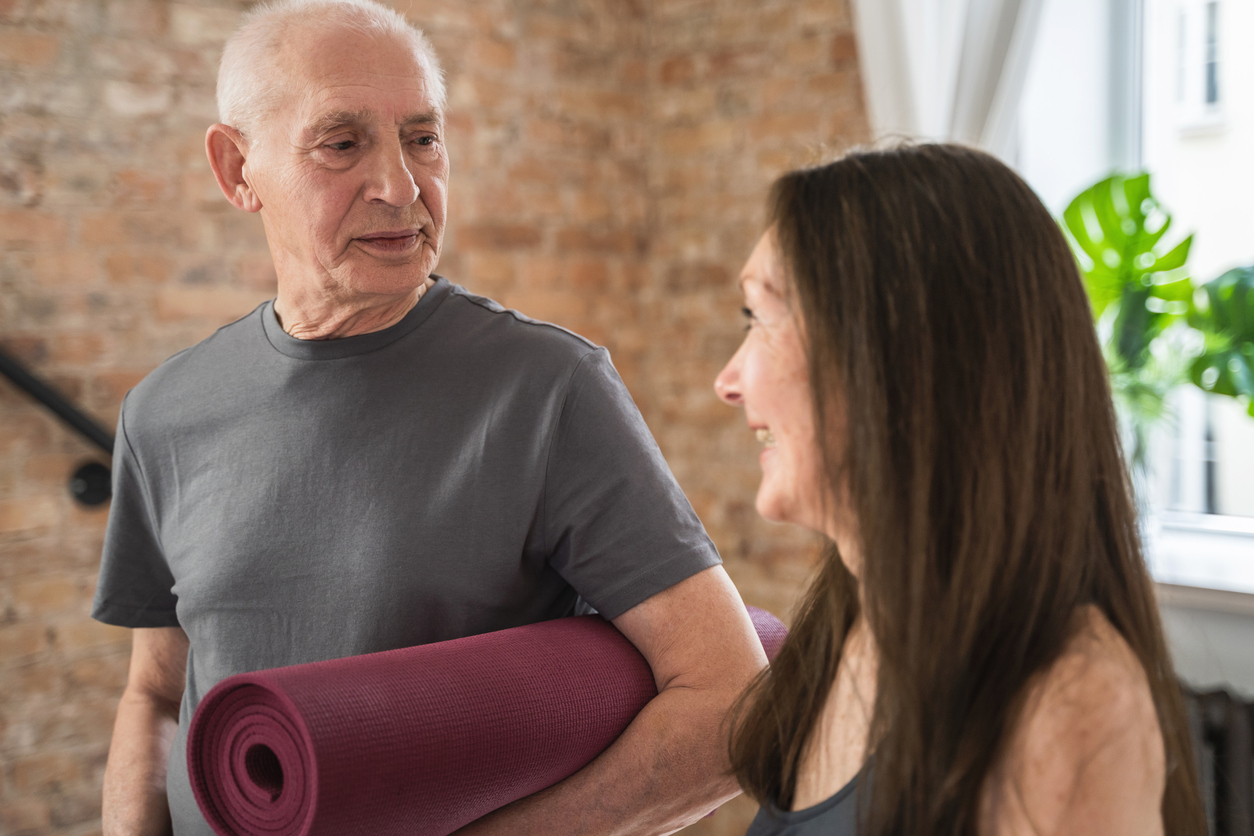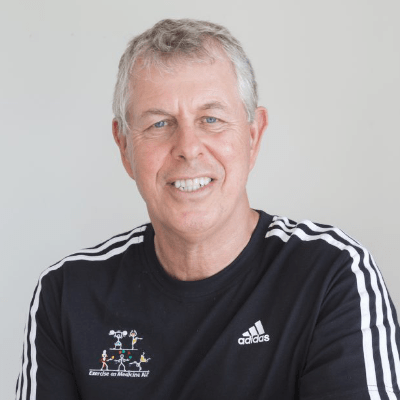Tim Webster looks at the impact a stroke can have on the body and how a fit pro can successfully train a stroke survivor.
You’re feeling a bit strange, then your arm starts to tingle, your words get mixed up and things start to go south from there. The next thing you know, you’re in the back of an ambulance with blue lights flashing and all hell breaking loose. Or you wake up in the middle of the night for what you think is a routine trip to the loo, only to find that one side of your body doesn’t appear to be functioning all that well and you struggle to make it out of bed. Your partner bundles you into the car and heads for A&E. Either way, chances are you’ve had a stroke.
When you get to hospital, the neurological team will want to establish whether it’s a block or a bleed; they are treated very differently. Once that’s done, they’ll go to work on minimising the damage to the brain that’s been caused by a lack of oxygen. Time is of the essence.
Once they’ve done that, you’ll be transferred to the ward, and pretty soon the hospital physios will start you on the road to recovery. A few weeks later, you’ll be placed in the care of the community team and sent home. They’ll help to get you settled – and then what?
An overloaded NHS does a great job in the acute and sub-acute phases of management and recovery, but with somewhere north of 100,000 strokes in the UK every year, there inevitably comes a point, somewhat sooner than everyone would like, that you’re on your own.
Notwithstanding the great work done by the Stroke Foundation <itals>et al</itals>, without a good support network many stroke survivors will inevitably descend into a big black hole. But some determined souls will make their way to your door. And that’s where the fun begins.
Restoring connections
Every now and again, you’ll see people with reasonably severe disabilities exercising by themselves in a mainstream gym. Forget them (in a nice way) – they are the elite 1%. Your average stroke survivor needs help over and above a standard gym programme.
There are two primary areas you need to focus on: regaining strength (power) in the impaired limbs and, more importantly, restoring damaged neurological connections.
“Think of everything you do as teaching the brain to reconnect with the body. Then repeat what you do over and over again until the brain gets it.”
Altered muscle tone
The brain does a perfect job of automatically maintaining the appropriate degree of muscle tone for all occasions, but a stroke will change all that. If the part of the brain that controls tone is damaged, the muscles may become hyperactive (high tone) or hypoactive (low tone). At either end of the tone spectrum, very high muscle tone is called spasticity and very low muscle tone is called flaccidity (which is often accompanied by weakness).
But that’s not the whole story. Spasticity isn’t just high tone, it’s high tone that’s velocity dependent; meaning that spasticity occurs when a limb with high tone is moved too quickly, causing a hyperactive stretch reflex to kick in and put the brakes on via increased muscle tone.
Abnormal muscle synergies
A stroke will often damage the neurological connections that enable efficient movement (synergy) patterns, which, no surprise, leads to abnormal movement patterns.
Extensor pattern
A lower limb (fancy name for leg) extensor pattern effectively links the hip, knee and ankle together such that when the hip extends, so does the knee and the ankle. The upshot of this is that, upon standing, the hip extends, the leg straightens and the foot points down.
We now have one stiff leg with minimal knee bend and a pointy foot with toes that stub into the ground, which makes walking difficult. This commonly results in a compensatory strategy called circumduction, which involves hitching the hip on the impaired side and swinging the leg round in a small semi-circle in order to clear the ground. It works but it’s very inefficient.
Let’s assume a lower limb extensor pattern is at play in the very first stroke client you ever see: what are you going to do about it? Breaking the rogue synergy pattern is a good place to start. That’s going to involve stretching and mobilising the joints in ways the brain, and therefore the body, will (initially) resist. If you can figure out how to put the hip into extension with the knee (and maybe foot) in flexion, and you can do it slowly because you know that rapid movement results in spasticity, you may have got the hang of this.
Let me throw in a small curveball here: while a pointed foot can be caused by spasticity, it can also be the result of foot drop (i.e., a weak, floppy foot). If you try to work on foot drop by slowly stretching the muscles that point the foot down (soleus, gastrocnemius, tibialis posterior), which would be a good plan for a spastic foot, you’re unlikely to have much luck. Which is why, if you really want to make a difference, you need to have some idea of what you are doing over and above your knowledge as an exercise professional.
By the way, you’ll find many stroke survivors with lower limb impairments will have an ankle foot orthotic (AFO) that’s designed to keep the foot in the right position. In my experience, most people want to get rid of their AFO because it’s ugly and uncomfortable, and go ‘barefoot’ so to speak. My view is that the AFO is there for a reason and alternating between AFO and barefoot is the way to go until the ankle-foot axis regains function.
Flexor pattern
An upper limb (arm) flexor pattern presents as protraction and internal rotation of the shoulder, with the elbow, wrist and fingers flexed, the forearm supinated and the hand in a ball.
The same deal applies with the upper limb as lower limb (i.e., the goal is to break the abnormal pattern and enable the joints to work independently of one another).
Before we get to that, let me pitch another curveball: the affected arm often goes into a state of flaccid paralysis immediately after a stroke. This leaves it heavy and immobile. If it’s not handled properly, this can lead to a subluxation of the shoulder, where the ball of the humerus partially dislocates from its socket (because the muscles of the rotator cuff can’t hold it in place) and the shoulder drops down. The hospital physios will manage the shoulder carefully during the early stages of recovery but, when the stroke survivor reaches you, the shoulder may still be vulnerable. All of which means that care needs to be taken when mobilising and stretching a shoulder where subluxation is an issue.
Just as an aside, you’d intuitively think that weight bearing through a subluxed shoulder would be out of the question. But actually, done properly, weight bearing can help to relocate the ball and socket.
Anyway, shoulder notwithstanding, the aim is to enable the stroke survivor to use their arm to selectively position the hand where they want it. This means working on shoulder abduction, elbow extension, forearm supination and wrist extension. And, when you’ve done that, it’s just a matter of restoring fine motor control of the fingers and thumb and the job’s done. I make light of it but, in reality, this is a hugely demanding process that will take hundreds of hours of work.
By the way, you may find that gently stroking the arm as you’re slowly straightening it will not only relax the muscles, but also help to stimulate the nervous system. If you can hum Brahms Lullaby in D major at the same time, it’s supposed to be super effective.
One more little curveball: if the joints of an impaired limb are left for a long period of time without moving, they will effectively seize up. This is called a contracture. So, when you are slowly extending a flexed arm and/or hand, don’t be surprised if you encounter a joint that’s a bit rusted up so to speak.
Repetition
You’ll no doubt be aware of the relatively recent discovery that the brain is plastic (neuroplasticity). Given the right input, a damaged brain can create new neural pathways to facilitate actions that have been compromised by an event like a stroke. There are two key things you need to understand about neuroplasticity:
- You need to feed the brain the right information – garbage in, garbage out, right – and …
- You need to do it time and time again.
The people who get the most from what we do are those who work equally hard in the gym and at home day after day.
Aphasia
In addition to compromising movement, a left-side stroke (always refer to the side of the brain which has been affected, rather than the side of the body) can also impact on the ability to speak and/or understand what is being said. This is because the primary speech and language centres are housed in the left side of the brain. This condition is called aphasia and it’s addressed by specialist speech and language therapists. Other than being incredibly frustrating for the stroke survivor, there’s no reason why aphasia should affect your ability to get on with the job at hand. In fact, some of my aphasic clients find articulating what they are doing, while they are doing it, very helpful: saying “sit … to … stand” while doing it, for example.
Ataxia
And lastly, I mention ataxia because it highlights something that affects many stroke survivors and that’s balance, or the loss thereof. Resulting from damage to the cerebellum, which governs co-ordination, balance and voluntary muscle control, ataxia often presents as a wide gait that makes the individual look as if they are drunk. Our work here involves teaching the brain not to panic when the feet get closer together, and we do this by putting the client into increasingly challenging, safely unstable positions (both static and dynamic) over and over again. This can be scary but the fear subsides as they realise they are supported and the perceived danger diminishes.
Complete recovery from a major stroke is hard to achieve but, if you can help stroke survivors to make physical improvements while teaching them to work with what they’ve got, it can make an enormous difference to their quality of life. An experienced conductive therapist once told me that I should always try to ‘work into the deficit’ and that has stuck with me. Look at where you can make the biggest difference and start there.
OK, I was kidding about the Brahms.
This previously featured in the Fitpro digital magazine.
To learn more from Tim about Stroke check out his online course – Stroke and the Exercise Professional








